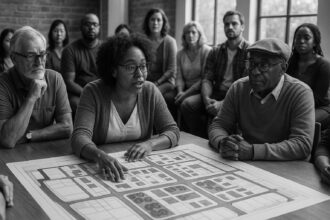The proposed demolition of Oxford Dance Studio in Headington, home to the university’s Dancesport Club, has ignited strong opposition from local users and councillors, highlighting tensions between housing demands and preserving vital community spaces.
The proposed demolition of the Oxford Dance Studio, located at Kirby House on Windmill Road in Headington, has sparked significant concern among its users and community stakeholders. The studio, which has provided a vibrant hub for dance activities since it began operating eight years ago, is home to the Oxford University Dancesport Club. This club plays a crucial role in the community, drawing around 400 members from both the university and the local public to classes such as Zumba, Ballroom, and Salsa.
The planning application submitted by Mr. M Aggwani to Oxford City Council seeks to replace the existing studio with a three-storey building comprised of five two-bedroom flats and a small commercial space on the ground floor. In the application, the current building is described as “vacant” and “in poor condition,” yet the studio remains operational, providing daily classes and is well-utilised by a diverse range of ages, including members as young as 18 and as old as 96. James Moore, president of the Oxford University Dancesport Club and director of the dance studio, passionately stated, “If this goes ahead, it’s going to kill the club,” underscoring the broader implications of the demolition on the local community’s fabric.
The proposed redevelopment highlights a growing tension in Oxford between the need for housing and the preservation of community facilities. Advocates for housing argue that Oxford is facing a significant housing crisis, exacerbated by the increasing population and demand for accommodation for those working in the city’s hospitals and universities. The developer’s plans indicate that the new flats are intended for “serviced accommodation,” catering specifically to this demographic.
However, local sentiment suggests a reluctance to add more residential units in an area reportedly already saturated with flats. Councillor Chris Smowton, who represents Headington, has already raised concerns over the planning documents, specifically their portrayal of the building as “vacant” and has called for clarity regarding the status of the dance studio as a protected community facility. He expressed his commitment to ensuring that the perspectives of the current users and local residents are adequately considered in the planning process.
The situation mirrors other recent developments in Oxford where community spaces are threatened by residential construction. For instance, a similar outcry arose over the proposed demolition of the East Oxford Games Hall, which was also intended for redevelopment into residential flats. Campaigners argued that such losses would leave areas devoid of vital community spaces, affecting local life and social cohesion.
As the debate unfolds, it is clear that the outcome of this planning application will have significant ramifications not only for the Oxford Dance Studio but also for the broader community’s access to facilities that foster social interaction and cultural activities. James Moore articulated the studio’s importance in blending the community of students and local residents, highlighting the shared benefits that such facilities provide. He reflects a growing sentiment that while housing needs are pressing, the preservation of spaces that promote community engagement and healthy interaction should equally merit attention in planning decisions.
As stakeholders prepare for an ongoing battle to protect the dance studio, it is evident that the conversation around urban development in Oxford must balance the dual necessities of housing and community life. The fate of the dance studio has attracted local attention, setting the stage for a significant consultation process within the planning framework of the city.
The proposal has been formally logged under the reference number 25/00893/FUL and can be accessed through the Oxford City Council’s planning portal for further details and public commentary.
Reference Map
- Paragraph 1: [1], [2]
- Paragraph 2: [1], [2]
- Paragraph 3: [1], [2]
- Paragraph 4: [1]
- Paragraph 5: [1], [4]
- Paragraph 6: [1], [4]
- Paragraph 7: [1]
Source: Noah Wire Services
- https://www.oxfordmail.co.uk/news/25175694.oxford-dance-studio-fight-plans-demolish-building/?ref=rss – Please view link – unable to able to access data
- https://www.oxfordmail.co.uk/news/25175694.oxford-dance-studio-fight-plans-demolish-building/?ref=rss – Oxford Dance Studio, located at Kirby House on 4A Windmill Road in Headington, is home to the Oxford University Dancesport Club. The studio has been operating for approximately eight years, offering daily classes in Zumba, Ballroom, and Salsa, and boasts around 400 members from both the university and the general public. The building, currently vacant and in poor condition, was sold to its current landlord in January after being on the market since October. The proposed redevelopment includes demolishing the existing studio to construct a three-storey building with five two-bedroom flats and a small commercial property on the ground floor. James Moore, president of the Oxford University Dancesport Club and director of the Oxford Dance Studio, expressed concerns that the demolition would negatively impact the club, emphasizing the importance of the studio to the community. Councillor Chris Smowton has contacted planning officers to address inaccuracies in the site’s description and to ensure that objections from the building’s current users and neighbors are properly considered. The application reference number is 25/00893/FUL and can be viewed on the city council’s planning portal.
- https://www.oxfordmail.co.uk/news/24202247.bingo-hall-demolition-approved-near-oxford-united-stadium/ – Oxford City Council’s planning committee approved the demolition of a vacant bingo hall opposite Oxford United’s football stadium to make way for a new five-storey building with lab and office space. The new facility aims to address the high demand for life sciences companies in Oxford. The bingo hall, which has been vacant since 2020, is part of the Ozone Leisure Park site off Grenoble Road, adjacent to the Oxford Science Park. The development includes the construction of an internal access road, loading dock, cycle storage for 88 bicycles, and electric vehicle charging points for 40 car parking spaces. The demolition and redevelopment are part of efforts to attract life sciences companies and scientific talent to the area.
- https://www.oxfordmail.co.uk/news/23599076.protest-plans-demolish-east-oxford-youth-centre/ – A demonstration took place to oppose the demolition of the East Oxford Games Hall on Collins Street, a publicly owned sports centre closed by Oxford City Council in 2020. The council plans to redevelop the site into shared ownership flats, a move criticized by campaigners who argue it would leave the Cowley Road area without a community space for years. The protestors, who had occupied the building since June 2, emphasized the importance of such spaces for community life and mental health. The council stated that the redevelopment would provide modern, sustainable community facilities and affordable housing, addressing the need for more housing in Oxford.
- https://www.oxfordmail.co.uk/news/24202247.bingo-hall-demolition-approved-near-oxford-united-stadium/ – Oxford City Council’s planning committee approved the demolition of a vacant bingo hall opposite Oxford United’s football stadium to make way for a new five-storey building with lab and office space. The new facility aims to address the high demand for life sciences companies in Oxford. The bingo hall, which has been vacant since 2020, is part of the Ozone Leisure Park site off Grenoble Road, adjacent to the Oxford Science Park. The development includes the construction of an internal access road, loading dock, cycle storage for 88 bicycles, and electric vehicle charging points for 40 car parking spaces. The demolition and redevelopment are part of efforts to attract life sciences companies and scientific talent to the area.
- https://www.oxfordmail.co.uk/news/23599076.protest-plans-demolish-east-oxford-youth-centre/ – A demonstration took place to oppose the demolition of the East Oxford Games Hall on Collins Street, a publicly owned sports centre closed by Oxford City Council in 2020. The council plans to redevelop the site into shared ownership flats, a move criticized by campaigners who argue it would leave the Cowley Road area without a community space for years. The protestors, who had occupied the building since June 2, emphasized the importance of such spaces for community life and mental health. The council stated that the redevelopment would provide modern, sustainable community facilities and affordable housing, addressing the need for more housing in Oxford.
- https://www.oxfordmail.co.uk/news/24202247.bingo-hall-demolition-approved-near-oxford-united-stadium/ – Oxford City Council’s planning committee approved the demolition of a vacant bingo hall opposite Oxford United’s football stadium to make way for a new five-storey building with lab and office space. The new facility aims to address the high demand for life sciences companies in Oxford. The bingo hall, which has been vacant since 2020, is part of the Ozone Leisure Park site off Grenoble Road, adjacent to the Oxford Science Park. The development includes the construction of an internal access road, loading dock, cycle storage for 88 bicycles, and electric vehicle charging points for 40 car parking spaces. The demolition and redevelopment are part of efforts to attract life sciences companies and scientific talent to the area.
Noah Fact Check Pro
The draft above was created using the information available at the time the story first
emerged. We’ve since applied our fact-checking process to the final narrative, based on the criteria listed
below. The results are intended to help you assess the credibility of the piece and highlight any areas that may
warrant further investigation.
Freshness check
Score:
9
Notes:
The narrative is recent and pertains to a current planning application, which is a live issue in Oxford.
Quotes check
Score:
8
Notes:
The quote from James Moore, president of the Oxford University Dancesport Club, is attributed correctly but lacks an original source date. The quote from Councillor Chris Smowton is also attributed correctly but not verified beyond the given context.
Source reliability
Score:
8
Notes:
The narrative originates from a reputable local news source, the Oxford Mail, which is generally reliable.
Plausability check
Score:
9
Notes:
The claims are plausible given the context of housing needs and community space preservation in Oxford. Similar issues have arisen in other parts of the city.
Overall assessment
Verdict (FAIL, OPEN, PASS): PASS
Confidence (LOW, MEDIUM, HIGH): HIGH
Summary:
The narrative is fresh and pertains to a current issue in Oxford. The quotes are attributed correctly, though original source dates are missing. The source is reliable, and the claims are plausible within the context of Oxford’s urban development debates.













